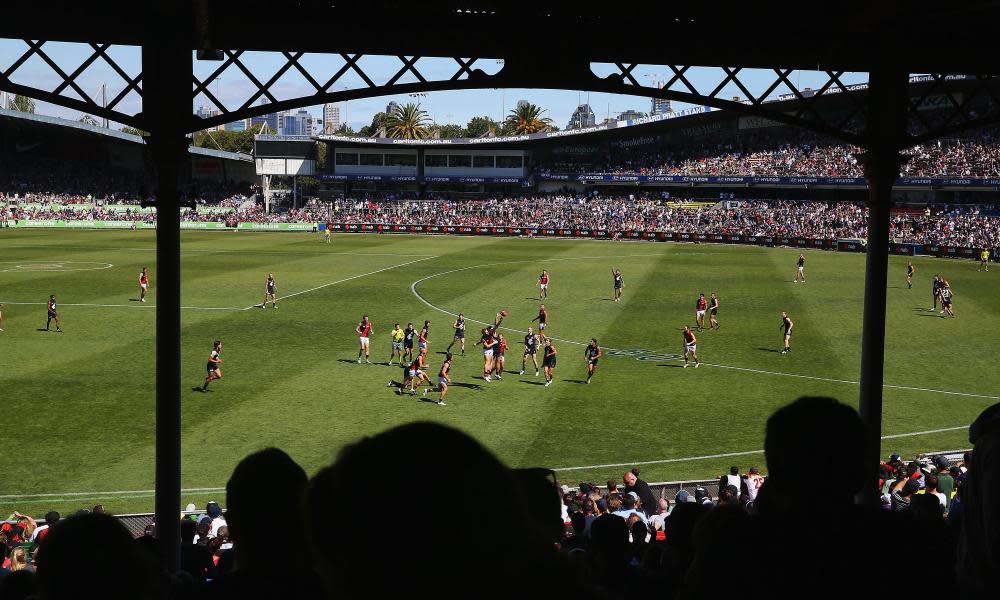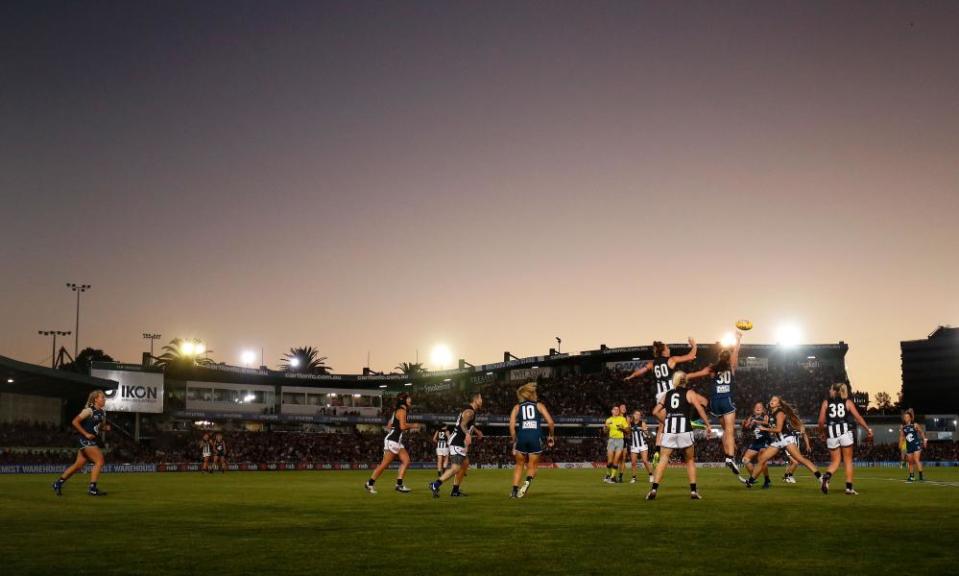A return to suburban grounds would offer a chance to reawaken the AFL's soul

“The whole of consumerism is based on us wanting the next thing rather than the present thing we already have,” Matt Haig laments in the book, Notes on a Nervous Planet. “This is an almost perfect recipe for unhappiness. We aren’t encouraged to live in the present, we’re trained to live somewhere else – the future.”
This immediately made me think of footy. I’ve been doing that a bit late. Maybe it’s the arrival of my first child on the cusp of the current season; probably it’s the absence of it since round one. I find myself daydreaming about what the game means to me now compared to other times in my life, not least my earliest years, where every memory is in brown and gold.
Related: Coronavirus shutdown has left a hollowness in the life of this AFL fan | Paul Daley
Perhaps it was also because Haig’s broader point relates to the way technology has accelerated life over the last two decades in ways incomparable to any other 20 years. From my vantage point – as nothing more than a fan – this felt analogous to our game. Never has top-level footy expanded this quickly. But, glib as it is to ask, is bigger necessarily better?
It feels opportunistic to cite this global crisis as a time to navel-gaze, but given the all-encompassing nature of the men’s AFL as it is today, it might be the best opportunity we will get. That’s not said to diminish the terrible spectre of job losses inside the game, either. Rather, this can be seen as a chance for footy to take a step back from the relentless day-to-day to take stock and consider what matters most when the post-pandemic world adjusts into a new normal.
For better or worse, we can be fairly sure that what will continue on the same path is the two-and-a-half hours between the sirens. Whether you fell into the evolution or revolution camp when the rules were being stress-tested a couple of seasons ago, the reality is coaches are blessed with supreme athletes capable of mastering a high-pressure and miserly game. We may all adore the high-scoring football played in generations past, but it’s not returning.
But one area where we might be able to row back a bit – not all the way back to the boatshed, but in the direction simpler times – is where games are played. Nothing quite summed up what Gerard Whateley foreshadowed as the “quirky and wonderful” season that might be possible towards the end of 2020 more than reports that suburban venues could be called upon to host games if the MCG is out of action due to Twenty20 World Cup commitments.
The politics of stadiums (or grounds, as we used to call them) is a complicated business – there is no disputing that. But if there is a desire at headquarters for the game to regain a bit of the intimacy that served it so well for a century, it might just be the right time to give this another, closer look in the years to come. Specifically Princes Park, the last ground of its kind to host a men’s game in 2005.
Reimagining how it might fit in again is not a new idea but is one that has case has been quietly bolstered in recent years as the spiritual home of the AFLW; it was packed to its 25,000 capacity for the opening game of the league in 2017. A year earlier, when Carlton’s men hosted Essendon in a pre-season kickabout, it was equally full. Back then, I wrote of the smiles of those in attendance, overjoyed to be back amongst the distinctive palm trees. It didn’t feel like sepia-filtered melancholy as much as it did a piece of the game’s soul reawakening.

After 1,277 VFL/AFL games since the very first season in 1897, Princes Park was eventually rationalised (to use league jargon), like every other suburban ground before it, primarily because of the bigger bucks elsewhere. There were other reasons too, which included how tough it was to get to. A positive legacy of the Docklands, though, is that the rhythms of attending games have changed now anyway – nobody drives anymore. And, conveniently, the Melbourne Metro railway station at Parkville is scheduled to open its doors in 2026.
Related: Pause due to Covid-19 gives AFL a chance to build a more agile and inclusive game | Rana Hussein
Of course, a facelift is required to make this happen on a permanent basis – a major one to bring it up to the standards now expected. But for proof of inspiration there, look no further than Kardinia Park. Indeed, the league have shown a canny knack for acquiring government support for projects such as these. Besides, this wouldn’t be about starting from scratch.
Upon completion, Princes Park would need to be an asset for all Melbourne clubs to enjoy in much the same way as VFL Park was from 1970 until 1990, rather than Carlton’s cash cow as it was when Hawthorn, Fitzroy and the Bulldogs were tenants at various times. Of course, the Blues would live there – it’s their home – but on the weekend it would be a ground where any Melbourne clubs could choose to fixture games as appropriate for a smaller capacity.
To that end, it’s worth remembering that for over a decade, the case has been made for a boutique, third venue to complement the MCG and the Docklands. Yes, the latter is now owned by the league so the punitive contracts for tenant clubs aren’t as troublesome as they once were, but attendance data reinforces that Princes Park is big enough to for this role. And, especially when full, it still looks fantastic on television.
Just last year, 14 of the 43 games at Docklands were played in front of fewer than 25,000 fans with four of those involving two local clubs. Two more Vic v Vic clashes were short of 30,000, which is what Princes Park would hold if a new stand were erected where the Robert Heatley Stand once was. A further three fixtures below that mark were hosted at the MCG.
By taking a selection of these lower-drawing games to Princes Park, the rich history of the game can be drawn upon to allow another generation to experience the magic of suburban footy in a modern light. This isn’t everything but it would mean plenty to loyalists. Sure, we’ll keep paying our money regardless – we’re clients for life – but footy has always been about more than that. Here’s a way for administrators to show they understand this as well. Above all, returning the AFL to one of its former cathedrals would restore the sense that football belongs to the suburbs as well as the city, and that Princes Park can be reclaimed as a home not just for Carlton, but for football.
Typically of his Watcher columns in The Age more than three decades ago, Garrie Hutchinson said it best: “In all the talk about the deprivations the football public is supposed to suffer when thousands can’t get into a game at Victoria Park or Princes Park, you’d think that football had merely become a way to raise the maximum amount of money. It hasn’t quite degenerated that far yet.” Let’s hope it never does.

 Yahoo News
Yahoo News 
